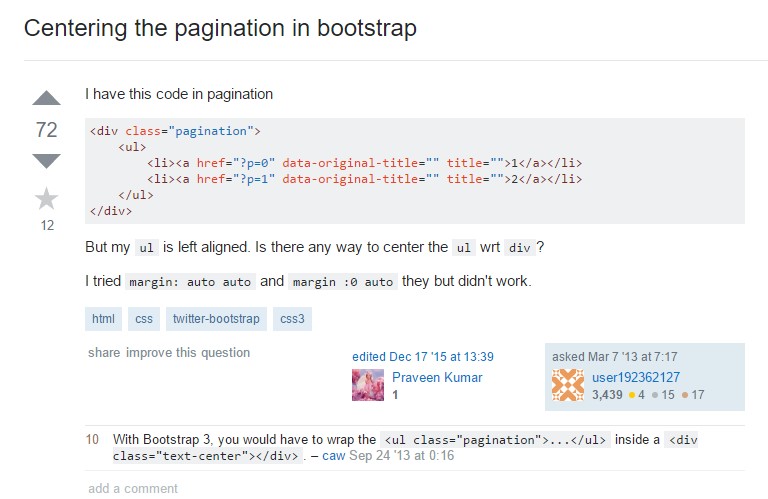Bootstrap Pagination Gridview
Intro
An upward trend in the front-end world is the use of CSS frameworks with base styles for our page. Instead of starting every project from scratch, creating every style in the hand, there are frameworks that already bring a whole built base from where we will start our application.
Bootstrap provides a number of capabilities:
● Totally reset CSS
● Base graphical style for the majority of the tags
● Icons.
● Grids ready for usage.
● CSS Elements.
● JavaScript Plugins.
● All responsive and mobile-first .
As its name proposes, it is a course to begin the project in a short time with a basic style and elements without exhausting design time in the start.
Practical pagination methods.
Paging becomes necessary Whenever we have a page with many items to display. We realize that in the case of listings, including presenting products in web stores or maybe search results in systems, the wish is not to expose all items simultaneously, but instead to handle them appropriately, helping to make them more convenient to gain access to, faster and more typical pages.
Listed here are some outstanding practices in the use of Bootstrap Pagination, despite the technology used ( learn more here)
Pagination: an excessive title.
Paging dispenses the title when well designed. That is , if you will need to write "Pagination" for the user of Bootstrap Pagination How to use, there is some thing wrong: consider redesigning it!
Really good visualness and positioning.
Paging is a completing navigation and really should provide good positioning and great presence. Use fonts with proportions and color tones that follow the design of web page usage, offering great presence and positioning it properly after the item listing ends.
Be simple.
Several paging tools deliver enhanced navigating features for example, going right to a targeted web page or advancing a specific quantity of pages at one time. They are extra features, users are more accustomed to simple shapes and do better with conventional models.
Produce grouping methods.
A fantastic and strongly recommended capability is to generate ordering solutions to optimize their use.
Do not apply subscript designs on web links.
In paging instruments, such features are unnecessary, because the links are visible and the subscript look will simply just leave the visional loaded. ( helpful hints)
Deliver proper place for clickable locations.
The larger the clickable local area the more available the buttons get and for that reason more convenient to put into action.
Deliver areas in between links
Spacing starting with one button to another will build paging much more user-friendly and comfortable , avoiding unwanted access.
Detect the present web page and deliver the standard navigation links.
The paging role is to provide user site navigation, so the tool should really make things understandable where the user is, precisely where he has been and the place he has the ability to go on.
Give primary navigation links such as "Previous Page" and "Next Page", regularly setting them at the beginning and finish.
Provide helpful shortcuts and additional help and advice
Links to the "first page" and "last page" are often handy, think about them in the event that it is necessary!
Use a wrapping
<nav>Additionally, as pages likely have more than just one such site navigation section, it's smart to provide a detailed
aria-labelaria-label="Search results pages"<nav aria-label="Page navigation example">
<ul class="pagination">
<li class="page-item"><a class="page-link" href="#">Previous</a></li>
<li class="page-item"><a class="page-link" href="#">1</a></li>
<li class="page-item"><a class="page-link" href="#">2</a></li>
<li class="page-item"><a class="page-link" href="#">3</a></li>
<li class="page-item"><a class="page-link" href="#">Next</a></li>
</ul>
</nav>Bootstrap Pagination
General Bootstrap Pagination Example
You may want to add some kind of pagination to each page if you have a site with many pages.
To produce a general pagination, add the
.pagination<ul>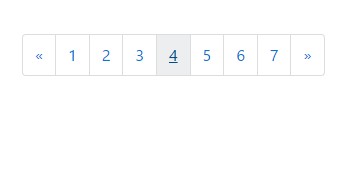
<nav>
<ul class="pagination">
<li class="page-item">
<a href="#" class="page-link" aria-label="Previous">
<span aria-hidden="true">«</span>
</a>
</li>
<li class="page-item"><a href="#" class="page-link">1</a></li>
<li class="page-item"><a href="#" class="page-link">2</a></li>
<li class="page-item"><a href="#" class="page-link">3</a></li>
<li class="page-item"><a href="#" class="page-link">4</a></li>
<li class="page-item"><a href="#" class="page-link">5</a></li>
<li class="page-item"><a href="#" class="page-link">6</a></li>
<li class="page-item"><a href="#" class="page-link">7</a></li>
<li class="page-item">
<a href="#" class="page-link" aria-label="Next">
<span aria-hidden="true">»</span>
</a>
</li>
</ul>
</nav>Bootstrap 4 and Bootstrap 3 changes
Bootstrap 3 only needs the
.paginationBootstrap 4, aside from the
.pagination.page-item<li>.page-link<a>Dealing with icons
Planning to take an icon or symbol in place of text message for certain pagination urls? Make sure to produce effective screen reader service with
aria.sr-only<nav aria-label="Page navigation example">
<ul class="pagination">
<li class="page-item">
<a class="page-link" href="#" aria-label="Previous">
<span aria-hidden="true">«</span>
<span class="sr-only">Previous</span>
</a>
</li>
<li class="page-item"><a class="page-link" href="#">1</a></li>
<li class="page-item"><a class="page-link" href="#">2</a></li>
<li class="page-item"><a class="page-link" href="#">3</a></li>
<li class="page-item">
<a class="page-link" href="#" aria-label="Next">
<span aria-hidden="true">»</span>
<span class="sr-only">Next</span>
</a>
</li>
</ul>
</nav>Active state
The active state indicates precisely what the present page is.
Add
.active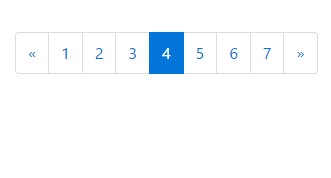
<nav>
<ul class="pagination">
<li class="page-item">
<a href="#" class="page-link" aria-label="Previous">
<span aria-hidden="true">«</span>
</a>
</li>
<li class="page-item"><a href="#" class="page-link">1</a></li>
<li class="page-item"><a href="#" class="page-link">2</a></li>
<li class="page-item"><a href="#" class="page-link">3</a></li>
<li class="page-item active"><a href="#" class="page-link">4</a></li>
<li class="page-item"><a href="#" class="page-link">5</a></li>
<li class="page-item"><a href="#" class="page-link">6</a></li>
<li class="page-item"><a href="#" class="page-link">7</a></li>
<li class="page-item">
<a href="#" class="page-link" aria-label="Next">
<span aria-hidden="true">»</span>
</a>
</li>
</ul>
</nav>Disabled Status
A disabled url can not be moused click:
Add
.disabled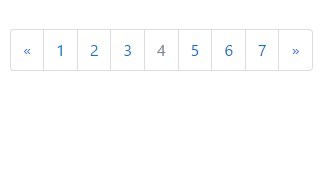
<nav>
<ul class="pagination">
<li class="page-item">
<a href="#" class="page-link" aria-label="Previous">
<span aria-hidden="true">«</span>
</a>
</li>
<li class="page-item"><a href="#" class="page-link">1</a></li>
<li class="page-item"><a href="#" class="page-link">2</a></li>
<li class="page-item"><a href="#" class="page-link">3</a></li>
<li class="page-item disabled"><a href="#" class="page-link">4</a></li>
<li class="page-item"><a href="#" class="page-link">5</a></li>
<li class="page-item"><a href="#" class="page-link">6</a></li>
<li class="page-item"><a href="#" class="page-link">7</a></li>
<li class="page-item">
<a href="#" class="page-link" aria-label="Next">
<span aria-hidden="true">»</span>
</a>
</li>
</ul>
</nav>Pagination Sizing
Paging blocks can also be sized to a bigger or small-scale sizing.
Add
.pagination-lg.pagination-sm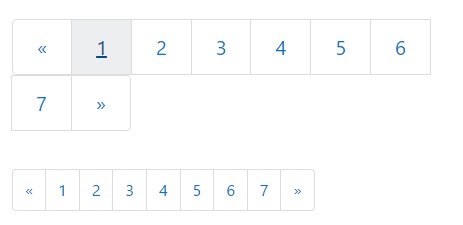
<nav>
<ul class="pagination pagination-lg">
<li class="page-item">
<a href="#" class="page-link" aria-label="Previous">
<span aria-hidden="true">«</span>
</a>
</li>
<li class="page-item"><a href="#" class="page-link">1</a></li>
<li class="page-item"><a href="#" class="page-link">2</a></li>
<li class="page-item"><a href="#" class="page-link">3</a></li>
<li class="page-item"><a href="#" class="page-link">4</a></li>
<li class="page-item"><a href="#" class="page-link">5</a></li>
<li class="page-item"><a href="#" class="page-link">6</a></li>
<li class="page-item"><a href="#" class="page-link">7</a></li>
<li class="page-item">
<a href="#" class="page-link" aria-label="Next">
<span aria-hidden="true">»</span>
</a>
</li>
</ul>
</nav>
<nav>
<ul class="pagination">
<li class="page-item">
<a href="#" class="page-link" aria-label="Previous">
<span aria-hidden="true">«</span>
</a>
</li>
<li class="page-item"><a href="#" class="page-link">1</a></li>
<li class="page-item"><a href="#" class="page-link">2</a></li>
<li class="page-item"><a href="#" class="page-link">3</a></li>
<li class="page-item"><a href="#" class="page-link">4</a></li>
<li class="page-item"><a href="#" class="page-link">5</a></li>
<li class="page-item"><a href="#" class="page-link">6</a></li>
<li class="page-item"><a href="#" class="page-link">7</a></li>
<li class="page-item">
<a href="#" class="page-link" aria-label="Next">
<span aria-hidden="true">»</span>
</a>
</li>
</ul>
</nav>
<nav>
<ul class="pagination pagination-sm">
<li class="page-item">
<a href="#" class="page-link" aria-label="Previous">
<span aria-hidden="true">«</span>
</a>
</li>
<li class="page-item"><a href="#" class="page-link">1</a></li>
<li class="page-item"><a href="#" class="page-link">2</a></li>
<li class="page-item"><a href="#" class="page-link">3</a></li>
<li class="page-item"><a href="#" class="page-link">4</a></li>
<li class="page-item"><a href="#" class="page-link">5</a></li>
<li class="page-item"><a href="#" class="page-link">6</a></li>
<li class="page-item"><a href="#" class="page-link">7</a></li>
<li class="page-item">
<a href="#" class="page-link" aria-label="Next">
<span aria-hidden="true">»</span>
</a>
</li>
</ul>
</nav>Transform the position of pagination components using flexbox utilities.

<nav aria-label="Page navigation example">
<ul class="pagination justify-content-center">
<li class="page-item disabled">
<a class="page-link" href="#" tabindex="-1">Previous</a>
</li>
<li class="page-item"><a class="page-link" href="#">1</a></li>
<li class="page-item"><a class="page-link" href="#">2</a></li>
<li class="page-item"><a class="page-link" href="#">3</a></li>
<li class="page-item">
<a class="page-link" href="#">Next</a>
</li>
</ul>
</nav>
<nav aria-label="Page navigation example">
<ul class="pagination justify-content-end">
<li class="page-item disabled">
<a class="page-link" href="#" tabindex="-1">Previous</a>
</li>
<li class="page-item"><a class="page-link" href="#">1</a></li>
<li class="page-item"><a class="page-link" href="#">2</a></li>
<li class="page-item"><a class="page-link" href="#">3</a></li>
<li class="page-item">
<a class="page-link" href="#">Next</a>
</li>
</ul>
</nav>Take a look at a few online video training regarding Bootstrap Pagination
Connected topics:
Bootstrap pagination approved records
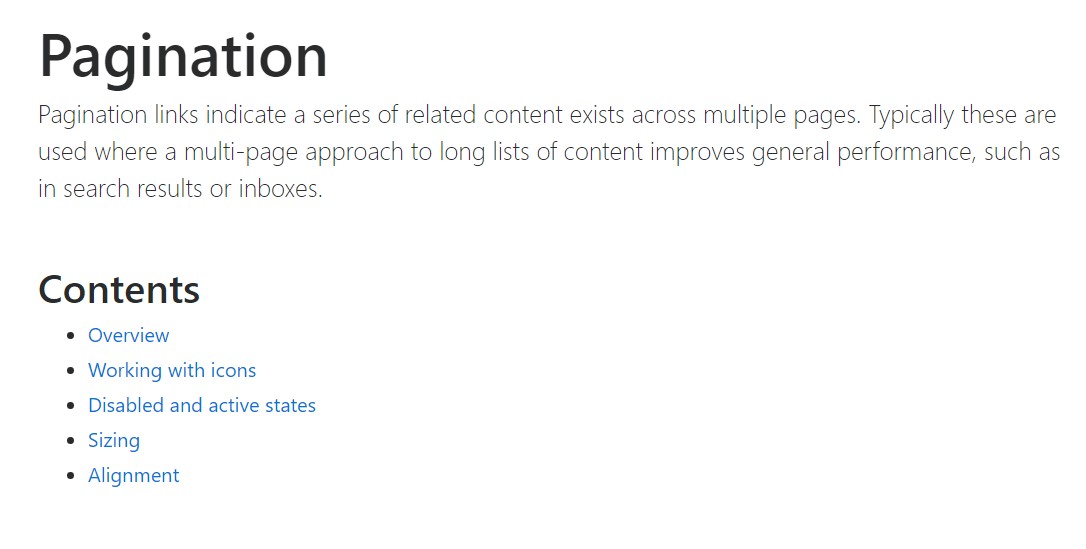
W3schools:Bootstrap pagination tutorial
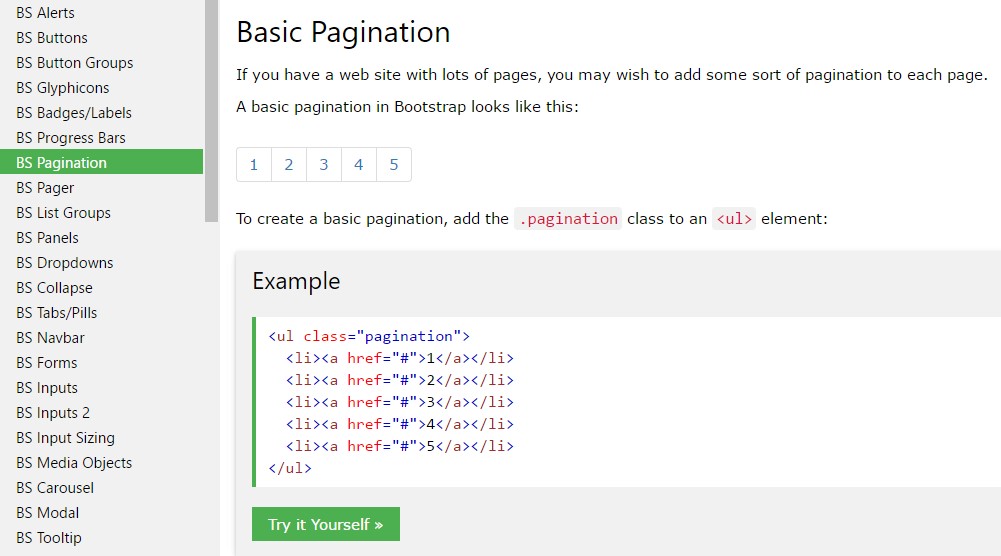
Centering the pagination in Bootstrap
